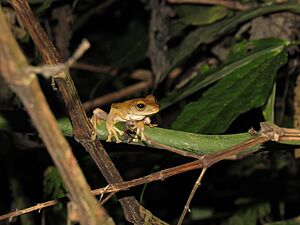Java flying frog facts for kids
Quick facts for kids Java flying frog |
|
|---|---|
 |
|
| Conservation status | |
| Scientific classification | |
| Synonyms | |
|
The Rhacophorus margaritifer, also known as the Java flying frog or Javan tree frog, is a type of frog. It belongs to the Rhacophoridae family. This special frog lives only on the island of Java in Indonesia. You can find it in several places across Java. Locals sometimes call it katak-parasut jawa, which means "Java parachute frog."
Contents
What Does the Java Flying Frog Look Like?
Java flying frogs have interesting features. Male frogs are usually about 41 to 45 millimeters (about 1.6 to 1.8 inches) long. Females are a bit bigger, growing to about 63 millimeters (about 2.5 inches) long. Their snout (nose area) looks pointed from above but rounded from the side.
Body Features
The frog's eardrum, called the tympanum, is easy to see. There's a small fold of skin above the eardrum. The skin on its back is smooth, while the skin on its belly is slightly bumpy. Its arms are short and thin, and its back legs are long and slender.
Feet and Colors
The fingers and toes of the Java flying frog have special sticky pads, called discs. These discs help the frog climb. They also have some webbing between their fingers and toes, especially the females. This webbing might help them glide. When preserved, these frogs can be tan, brown, or gray. Male frogs often have small black spots on their backs.
Special Defense Move
Sometimes, the Java flying frog will do something called an unken reflex. This is a defense move where the frog arches its back and shows off bright colors on its belly or inner limbs. It's a way to tell predators, "Stay away!"
Where Does the Java Flying Frog Live?
The Java flying frog lives in forests, both in low areas and on mountains. You can find them at heights from about 900 to 1,795 meters (about 2,950 to 5,890 feet) above sea level. They can even live in forests that have been slightly disturbed by people.
Reproduction and Breeding
These frogs like to lay their eggs and raise their young in streams. The streams provide a safe place for their babies to grow.
How Are We Protecting This Frog?
The Java flying frog faces some challenges. One big problem is habitat loss. This happens when forests are cut down for small farms or for collecting wood.
Threats to Their Survival
Another concern is a frog disease called Batrachochytrium dendrobatidis. This disease is caused by a fungus. While it has been found in these frogs, scientists are not sure if it is causing their numbers to drop. Some of these frogs are also caught and sold as pets. There's a limit, or quota, of 900 frogs that can be taken for the pet trade each year.
Protected Areas
Luckily, the Java flying frog lives in several protected areas. These areas help keep their homes safe and give them a better chance to survive and thrive.


